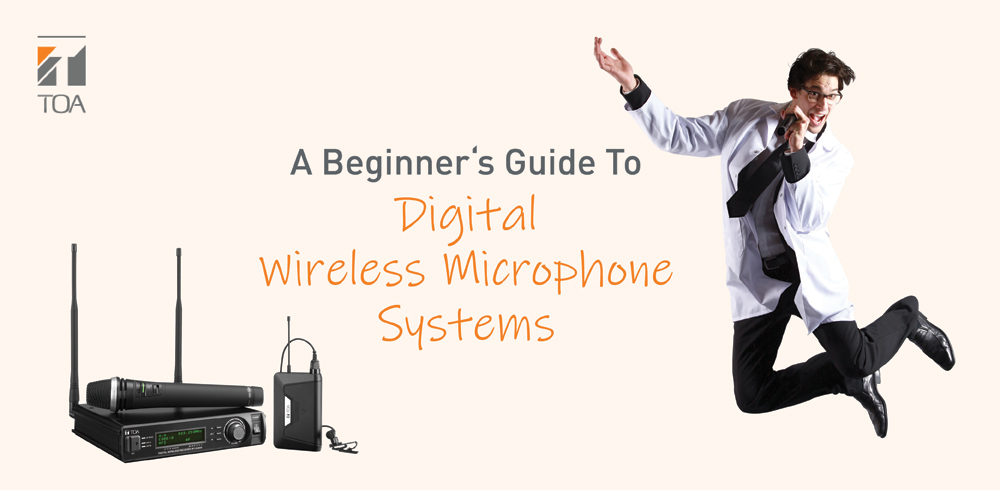Beginner's Guide to Digital Wireless Microphone Systems

Beginner's Guide to Digital Wireless Microphone Systems
How do digital wireless microphone systems work?
Let’s first take a look at how a digital microphone works.
A digital microphone picks up analogue sound waves and converts them into digitally modulated audio signals.
Meanwhile, a digital wireless microphone system consists of a digital microphone, a wireless transmitter, and a wireless receiver.
How do digital wireless microphone systems work?
Let’s first take a look at how a digital microphone works.
A digital microphone picks up analogue sound waves and converts them into digitally modulated audio signals.
Meanwhile, a digital wireless microphone system consists of a digital microphone, a wireless transmitter, and a wireless receiver.
As a simplified summary, the microphone receives wave vibrations and converts them to analogue electrical signals. The digital sensor then encodes them into digital signals.
Next, the transmitter relays the digital data to the receiver. The receiver picks up the digital signals and converts them back into sound.
What advantages do digital wireless microphones have over analogue microphones?
Digital microphones are extremely resilient to interference. Also, the unique information concealment technology (Encryption Setting function) in TOA's WM-D5200 digital wireless microphone enhances confidentiality and security against eavesdroppers.
They rarely experience noise and static as their signals are not affected by the transmission medium, unlike analogue microphones.
What advantages do digital wireless microphones have over analogue microphones?
Digital microphones are extremely resilient to interference. Also, the unique information concealment technology (Encryption Setting function) in TOA's WM-D5200 digital wireless microphone enhances confidentiality and security against eavesdroppers.
They rarely experience noise and static as their signals are not affected by the transmission medium, unlike analogue microphones.
Digital wireless microphones are also highly portable, with no wires to hold you down. Fewer accidents happen on stage as there is little wire clutter, improving the overall stage experience.
Is there any interference if I use a digital wireless microphone system?
Radio frequency interference may happen, regardless if the system is analogue or digital. Co-ordinate your wireless systems to avoid direct interference from other UHF wireless sources. At the same time, use a set of frequencies that don't interfere with each other.
Is the audio range for a digital wireless microphone comparable to an analogue microphone?
Both systems convert audio into a radio signal and back through either analogue or digital processes. The audio range is largely similar between both systems.
Hands-free or handheld? What type of digital wireless microphone should I use?
A handheld digital wireless microphone with a built-in transmitter is held by the presenter or vocalist. The volume can vary by changing the distance between the sound source (i.e. mouth) and the microphone. This is especially helpful for those who need varying volume levels like live singers.
Is there any interference if I use a digital wireless microphone system?
Radio frequency interference may happen, regardless if the system is analogue or digital. Co-ordinate your wireless systems to avoid direct interference from other UHF wireless sources. At the same time, use a set of frequencies that don't interfere with each other.
Is the audio range for a digital wireless microphone comparable to an analogue microphone?
Both systems convert audio into a radio signal and back through either analogue or digital processes. The audio range is largely similar between both systems.
Hands-free or handheld? What type of digital wireless microphone should I use?
A handheld digital wireless microphone with a built-in transmitter is held by the presenter or vocalist. The volume can vary by changing the distance between the sound source (i.e. mouth) and the microphone. This is especially helpful for those who need varying volume levels like live singers.
A hands-free digital wireless microphone consists of a lapel (or lavalier) microphone and a body-pack transmitter, or a headset microphone and body-pack transmitter. As the distance between the sound source and microphone is fixed, this gives the speaker a consistent volume. It is suitable for those who need maximum freedom of movement like fitness instructors, lecturers, or stage actors.
Do I use single-use batteries or rechargeable batteries for my digital wireless microphones?
With rechargeable batteries, you can skip last-minute trips to purchase single-use batteries before a gig. Rechargeable batteries are also shown to be more cost-efficient, with cost-savings shown during the one-year mark during an experiment.
Do I use single-use batteries or rechargeable batteries for my digital wireless microphones?
With rechargeable batteries, you can skip last-minute trips to purchase single-use batteries before a gig. Rechargeable batteries are also shown to be more cost-efficient, with cost-savings shown during the one-year mark during an experiment.
If you’re using the wireless system for less than one year, you can consider getting single-use batteries.
Conclusion: Digital or analogue wireless microphone system - which do i choose?
Below are a few tips so you can consider which system to get.
Conclusion: Digital or analogue wireless microphone system - which do i choose?
Below are a few tips so you can consider which system to get.
Use a digital wireless microphone system if:
· You need privacy and a secure transmission
· You want to eliminate all possibility of interference
Use an analogue wireless microphone system if:
· You don’t need privacy and a secure transmission
· Your programme is conducted in open environments, with little interference
Overall, both wireless microphone systems offer their own benefits and it depends on your own individual needs when choosing a digital or analogue system.









